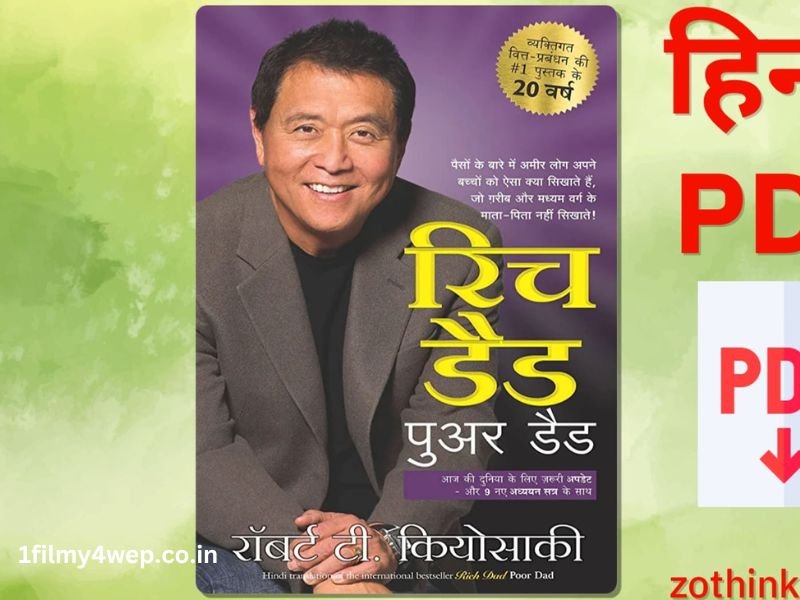In today’s fast-paced world, financial literacy is more important than ever. Rich Dad Poor Dad emphasizes that traditional education doesn’t teach people how to manage money, invest wisely, or understand the difference between assets and liabilities. Instead, it encourages readers to take control of their financial future by educating themselves about money, investing, and entrepreneurship.
Table of Contents
- 1 The Power of Financial Literacy in “Rich Dad Poor Dad”
- 1.1 Why Rich Dad Poor Dad is a Must-Read for Hindi Speakers
- 1.2 Key Takeaways from Rich Dad Poor Dad
- 1.3 How the Hindi PDF Version Makes Financial Literacy Accessible
- 1.4 The Role of Rich Dad Poor Dad in Changing Financial Perspectives
- 1.5 How to Use Rich Dad Poor Dad to Improve Your Financial Situation
- 2 Final Thoughts: Empowering Hindi-Speaking Readers with Financial Wisdom
The Power of Financial Literacy in “Rich Dad Poor Dad”
By reading Rich Dad Poor Dad in Hindi, individuals who may not be familiar with English or financial jargon can still understand these critical concepts. The book has been widely acclaimed for simplifying complex financial ideas, making them accessible to everyone, no matter their background or profession.
Why Rich Dad Poor Dad is a Must-Read for Hindi Speakers
For Hindi-speaking readers, Rich Dad Poor Dad offers an opportunity to learn crucial financial principles in a language they understand. The book has gained popularity worldwide due to its straightforward approach to wealth-building and its focus on financial independence.
In countries like India, where financial literacy is still an emerging concept, Rich Dad Poor Dad serves as an eye-opener. It encourages people to think beyond just earning a paycheck and to focus on building assets that provide passive income, helping them achieve financial freedom over time.
Key Takeaways from Rich Dad Poor Dad
- The Importance of Mindset: One of the central themes of Rich Dad Poor Dad is that wealth-building begins with a mindset shift. Rather than focusing on working for a paycheck, Kiyosaki stresses the importance of learning how to make money work for you. For Hindi-speaking readers, this principle can be an empowering realization, as it breaks down the limiting beliefs around money that many people in India have.
- The Cash Flow Quadrant: Kiyosaki introduces the concept of the Cash Flow Quadrant, which is an essential tool for understanding different ways to generate income. It divides people into four categories: employees (E), self-employed (S), business owners (B), and investors (I). The book explains how transitioning from being an employee or self-employed to being a business owner or investor can lead to financial freedom.
- The Importance of Real Estate Investment: Another key lesson from Rich Dad Poor Dad is the value of real estate investment. Real estate is often referred to as the cornerstone of wealth-building. In the Hindi version of the book, this lesson resonates with readers, especially in India, where real estate is a lucrative and culturally important investment option.
- Entrepreneurship and Risk-Taking: Entrepreneurship plays a significant role in Kiyosaki’s philosophy. He encourages readers to think like entrepreneurs, create opportunities, and take calculated risks. This message, conveyed in Hindi, empowers aspiring business owners in India to pursue their goals and overcome the fear of failure.
How the Hindi PDF Version Makes Financial Literacy Accessible
The Hindi PDF version of Rich Dad Poor Dad allows readers to easily access and understand the key principles of the book. The digital format makes it convenient for those who prefer reading on their devices. With the growing number of online platforms offering free downloads of the Hindi version, more and more people are discovering the book’s powerful message about financial education.
Reading in one’s native language significantly enhances comprehension, and for many Hindi speakers, this is the most effective way to absorb the material. Moreover, it makes the lessons more relatable by connecting them to their daily lives and financial aspirations.
The Role of Rich Dad Poor Dad in Changing Financial Perspectives
Rich Dad Poor Dad encourages readers to break free from the conventional path of working a 9-to-5 job and relying on a salary for financial security. Kiyosaki challenges the traditional view of going to school, getting a job, and saving money in a bank. Instead, he advocates for continuous learning, making smart investments, and building multiple streams of income.
For Hindi-speaking readers, this perspective can be transformative. The book shows how people from all walks of life can attain financial independence by making the right financial decisions, regardless of their educational or professional background. By sharing personal anecdotes and experiences, Kiyosaki illustrates how anyone can start building wealth, even if they don’t have significant capital or resources at the beginning.
How to Use Rich Dad Poor Dad to Improve Your Financial Situation
- Take Control of Your Financial Education: The first step is to take control of your financial future by educating yourself. Kiyosaki encourages readers to learn the basics of accounting, investing, and personal finance. This knowledge will help you make informed decisions and identify opportunities that will build wealth over time.
- Focus on Acquiring Assets: Instead of spending money on liabilities that drain your finances, focus on acquiring assets that generate income. Kiyosaki suggests investing in real estate, stocks, and businesses that can provide passive income streams.
- Start Small, Think Big: Whether you’re just starting out or already have some experience in managing finances, Rich Dad Poor Dad teaches you the importance of starting small and scaling up your efforts. Kiyosaki’s philosophy emphasizes that building wealth takes time, but with persistence and smart choices, anyone can achieve financial freedom.
- Avoid the Rat Race: Rich Dad Poor Dad encourages readers to escape the traditional “rat race” of living paycheck to paycheck. By focusing on building wealth through investments and entrepreneurship, you can create a life where money works for you instead of the other way around.
Final Thoughts: Empowering Hindi-Speaking Readers with Financial Wisdom
Rich Dad Poor Dad is more than just a book about money; it’s a guide to achieving financial independence and living life on your own terms. For Hindi-speaking readers, the book’s translation makes these timeless financial principles accessible, offering invaluable insights into money management and wealth-building.
By reading Rich Dad Poor Dad in Hindi, readers can embark on a journey of financial literacy that will help them make smarter decisions with their money, create sustainable income streams, and ultimately achieve their financial goals. Whether you’re an aspiring entrepreneur or someone looking to improve your personal finances, the lessons in this book are sure to resonate and guide you towards a brighter financial future.







